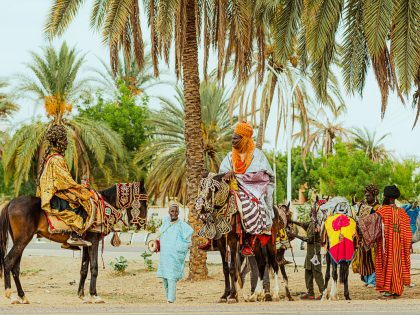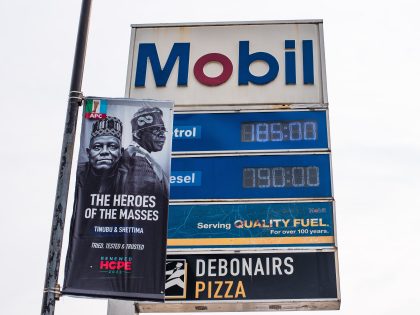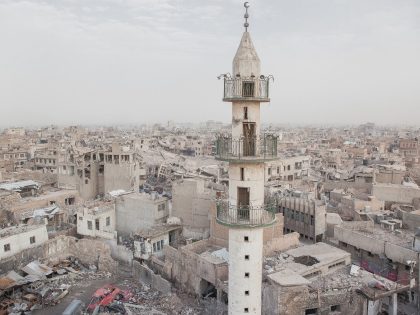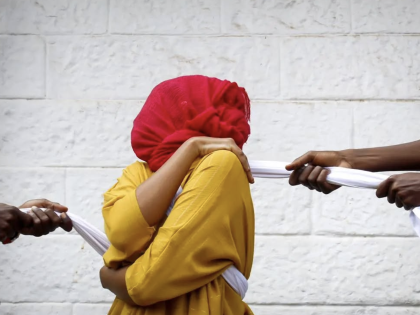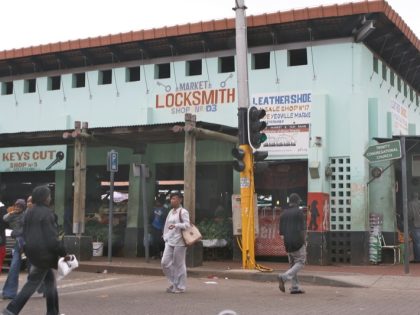The art of Victor Ehikhamenor

Victor Ehikhamenor’s images always work as a proliferation of forms. It’s the sort of proliferation that explodes in your face, making the shapes and objects something other than shapes and objects. Too much is happening, which is the imperative for this transaction—no space is left uncontained. These images and objects embody forms; to uncover any inherence or indwelling in the work, you look at the operations of the forms. To be clear: “forms” here refer to figures, shapes or appearances. In other words, the way things appear or are shaped.
Shapes emerge because there’s a creator behind them, at least in this case. A number of the canvasses are folded into deliberate forms, becoming objects on display, personable items. A way to begin to look at Ehikhamenor’s work is to seek the fount of immanence where these forms arise. Once this question is asked shapes begin to become visible in the images; you see a panoply of heads in “The Whirlwind Dancers of Uwessan” (below) a hand pointing onwards in “The Messenger from Yesterday,” a cloaked head in “The Forgotten Memories We Carry.” Deliberateness, agreeably, is the first imperative for form. This does not to suggest that at the moment of painting, every painter has an image in mind (although some admit to occasionally do). It’s to propose that one can be drawn, instead, to the deliberate result of the painting process in canvasses by Ehikhamenor that are creased at the right spots.
According to Flusser, it’s impossible to be the designer and creator of the world and at the same time submit to it. The deliberateness you should consider is one that affirms the authorial prerogative of the painter. Each image is a world according to certain painterly virtues and obligations. If you think about the building bricks of this world, these images, they would be the shapes that emerge as folded canvasses and mythical figures layered on other mythical figures. Take “Struggle for Big Afro Mama” as an instance, where figures live within figures, a landscape of forms.
To think about Victor Ehikhamenor’s work, one returns to his artisanship. An artisan is a workman, someone who makes, and the idea of design and precision is central to his practice (“he” because, of course, the painter here is a man). At first, and on the surface level, might attribute the exactness of his lines and curves to his use of charcoal, a kind of pen that brings minutia into full visibility—take a look at “A Man of the People.” But diving deeper into the meaning of his artisanship, one finds a careful orchestration, a tapering narrative. This artisanship does not aim to create forms or objects for the sake of utility, unlike what a carpenter or mechanic would do. The lines have been made to fall in pleasurable places—you have to think of this artisan the same way you think of a master architect. The architect aims for a combination of esthetics and perfection; “architecture is frozen music,” Goethe is quoted to have said. You wouldn’t find a stray line, curve or figure in the artisan-architect’s drawing. Every inch covered becomes a perfect line, and when you take a look you’re reminded of a tone from a great song you can’t seem to get off your mind.
Artisanship implies exactness, and this in turn implies clarity. As visible objects, the forms in these images are clear enough. Yet they make additional claims. Out of this exactness emerge other possible clarities. Regardless of the pleasure you get from looking, the lines point you to a meaning within the images. “Not The First Time You Are Telling Me This Story” typifies this. Meaning wouldn’t suggest a definite idea, but the possibility of reflection. In other words, the images become exact and pleasurable in order to entertain the possibility of reflection. And reflection isn’t any logical act or process— in Not The First Time You Are Telling Me This Story”, where figures are layered on figures, if anything, follows the logic of a maze. Reflection is the condition that allows for the coexistence of ideas, stories, histories and personas.
There’s a way in which the use of color in the series “This Is Not a War Story” troubles the coherence of the other series in this exhibition. Nothing before has prepared you for color spreading across the paper, as though it’s the spill of blood or the annexation of territory or the discoloration of landscape. In the earlier images, color is used to illumine essence, to give quality to form. Here it antagonizes form, as though each paper has become a battleground. It’s an example of war that derides war—the blood flows freely now in Northern Nigeria, news that is no longer news. In putting colour upon colour the images demand a similar political virtue: perhaps, after all, there might be a way to tell the story of war as not war; to find that in a bloodied country there are traces of humanity, kindnesses that haven’t been smeared with violence.

All along this essay has offered a way to look at Ehikhamenor’s work as an immediate encounter with form. Yet now it becomes necessary to turn to overarching matters. From the outset, the images are implicated by their titles. Each presupposes that narratives and personas are within the forms and figures, and within these forms and figures are symbols and keys and entrances. Each title is the prompt with which you can navigate the mythical realities of the object’s worlds. “Floating In The City of Dreams” will hardly suggest nothing else but floating, and without doubt you notice a head, arms outstretched, legs afloat, legs sweeping over waves.
Turning to the idea of Ehikhamenor’s titles as prompts: “I Hope You Remember” is tied at two parts of the canvas, making the image a tripartite object. At once St. Augustine’s words become pertinent: “There are three times: a present of things past; a present of things present; and a present of things future.” It would seem that to deal with this sculptural object – and others that have similar titles, like “Tell Me What I Won’t Forget (top of this post) – you’ll have to consider presence as the shared ontology of the past, present and future. Images are always present; they live everlasting lives in the subconscious of their beholders. Yet it is not this kind of presentness that Ehikhamenor’s images give; it’s the presentness of history, the Augustinian presence of things that oscillates between past, present and future. In my mind, images have no past, present, or future. They stretch across time. And when the painter is moved to populate his images with presentness, like Ehikhamenor has done, the history that is embodied will stretch across time as well.
Regardless of how they’re rendered on the surface – by charcoal, acrylic, enamel, nail perforations – Ehikhamenor’s intent is that these images portend an enchanted world inspired by folktales and city life, by stories real and imagined. The painter is a storyteller, although an unreliable one. That is, unreliable if you what you’re seeking is for the image to bear chronological narratives. For instance, what time-chart could there be for “Samson and Jezebel in Lagos?” Already you have a title that says only what is sufficient: here are the figures of lovers in a big city, populated with the lines and curves of their desires. Nothing more can be said because within the image everything has been said, a complete instant. The perforated figures make this even clearer. It’s the crispness of their visages that make them powerful—each dot is covering additional ground until the painter-artisan comes full circle.
In sum, Victor Ehikhamenor’s images show a type of human body consistent with an enchanted world. The images, in fact, are dispersive chronicles of an enchanted world. In one sense, enchantment is suggestive of delight. No doubts can exist about the fact that Ehikhamenor paints with humour on one hand and wit on the other (take a look at “Waiting along the Hallway of Pleasure”: notice for starters the shapes, sizes and position of the heads, and notice the gestures of the hands). You shouldn’t undermine delight as a pathway to enchantment. These images have to work as a spell does, charming and drawing in, until each beholder has an alternate chronicle of enchantment.
* Top: “Adam and Eve waiting for a flight out of Eden.”









